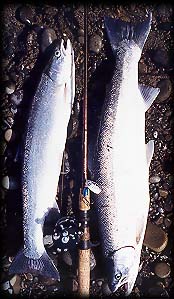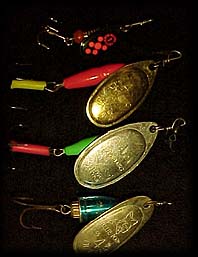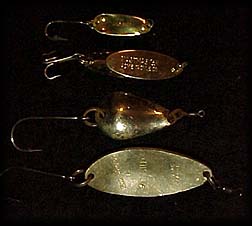|


|
- Recommend Reading for Anglers -
- Visit the
Forums Section for lots of
discussion by anglers of Pacific Northwest fishing!
|
|
|
Please Visit One of the Companies Helping to Bring You the Resource Center!
 |
|
Just about any conventional tackle angler has at one
time tried a piece of hardware for either salmon or steelhead. Perhaps the most simple of
the terminal tackle used by anglers, it may very well be the hardest to master.
Although an old favorite of Bob's for steelhead fishing, rarely do we
spend an entire trip tossing spinners or spoons unless specifically requested by a
customer.
In this section, we will take a look at fishing the
various types of hardware for both salmon and steelhead and briefly touch upon the pros
and cons of fishing hardware.
Spinners
|

A pair of Bogachiel winter-run
steelhead caught on a Blue Fox Spinner. |
|
Perhaps the most familiar of all
artificial lures. Spinners, when used in the right manner are an excellent way to entice strikes from
both the salmon and steelhead finning the waters of any Pacific coast
stream. They come many different shapes, sizes, and colors, and many of the
choices work quite well; however, as is the case with most types of terminal
tackle, the biggest influencing factor is not what you use but rather how
you use it.
Most people have trouble
catching fish on spinners for one reason: they are not able to keep the lure
near the bottom, a must for consistent success. On the other hand, spinners
give anglers an opportunity to effectively fish pocket water and very slow
moving areas with sometimes very good results. The key is presentation, and
we'll help you a little with that. Below, we'll break our spinner fishing
discussion into two parts: one for salmon fishing; one for steelhead
fishing.
Steelhead Fishing
|
|
Choosing a Spinner ... the choice of spinner to use
for steelhead fishing varies widely with the water conditions that an angler will
encounter. For summer-run fish in warmer, clearer water flows, a smaller spinner is likely
the best choice ... sizes 1 to 3 are very popular with 4's a good choice when some weight
is needed or fishing heavy water in which you'll find many of the summer runs. For winter
runs, 4's and 5's are far and away the most common size choices with the smaller spinners
making an occasional appearance.
Finishes vary a lot too. For the low
clear water of summer, brass blades are very popular and black finished spinners are an
excellent choice (see our
tip on blackening brass
spinners). In the winter, the brighter finishes of nickel, silver, and gold are
most popular.
These brighter finishes are often paired with brightly colored painted
bodies to give the lure more visibility that is often needed to entice strikes in the
higher, dirtier winter flows. The picture on the right shows some of our favorite
spinners. Some are commercial products, others are ones that we build ourselves.
|

An example of some spinners that
work equally well for salmon and steelhead. |
|
Keep in mind that there is no such thing as the 'only
lure to use'. When selecting selecting a spinner for steelhead fishing, there are a couple
of things to look for: first of all, weight ... the biggest problem with fishing spinners
is keeping them down in the strike zone of the fish (that means on or near bottom in most
cases) ... choose the heavier weighted spinners for steelhead fishing, especially in
winter flows. The second thing that you should look at are the finish types. A little
known quality of brass or nickel blades is their poor underwater reflective ability, in
the case of both these finishes, they lose much of their reflective quality just a few
feet underwater, this is okay when fishing cleaner water, but if you are looking for
something to 'wake those fish up', you'll need to select spinner finishes of real
gold or silver for maximum flash underwater.
While gold blades are hard to find in
a finished commercial product, they are readily available from component retailers. Silver
plated finishes are easier to find right on the shelves of the tackle store, Mepps and
Blue Fox products are both available in silver-plated finishes.
Fishing the spinner ... while spin casting equipment
is often associated with spinner fishing, we still prefer traditional baitcasting
equipment for spinner fishing with the exception of those times when very light spinners
are used. Why? Because traditional levelwinds offer greater casting accuracy and the
ability to freespool line when needed.
Although there are a few
occasions when a cast and steady retrieve is your best option, in most cases, spinners are
most effective in a cast and swing presentation like you would use in driftfishing.
Because the spinner will want to lift towards the surface near the tail end of the swing,
it is best to choose a piece of water that has a slower flow at the end of the drift in
order to keep the spinner down in the strike zone. Or, if feasible, feed out small amounts
of line to counteract the spinner's lift and help keep it down on the bottom. The diagram
below gives a rough idea of the steps in fishing a spinner.

Remember, that you don't need the blade spinning at a
furious rate to be effective, as long as the blade is working, the lure will be effective
... other than initially reeling in the slack at the beginning of a cast to keep a tight
line to the spinner, reel only enough to keep the blade moving and creating enough lift
with the turning blade to keep the lure from hanging on bottom. A good rule of thumb in
spinner fishing is to incorporate no or a very slow retrieve in fast water and use
slightly faster retrieves in slower water. Your goal is to present the spinner to a fish
as slow as possible in most instances.
Although some of your strikes will be
hard, others will not; in fact, sometimes it will seem as if your spinner simply caught
bottom. If this occurs, simply lift on rod and if you feel any sort of tug back ... strike
hard and fast!!!
|
Salmon Fishing
Spinners are used more often for salmon as many
salmon will hold in very slow moving water that is very effectively fished with a spinner.
Salmon also have a greater tendency to move to hit a spinner than steelhead ...
especially silvers (or coho).
Spinner sizes usually range from 3's to 6's with 4's being our favorite in
most instances. Finish / color combinations are still a matter of personal preference,
however our long time favorites are red body / silver blade and chartreuse body / 24k gold
blade. Smaller spinners are sometimes used in very low, clear water conditions with some
success, however, we have found a couple of other 'secret weapons' to use in these
conditions with a little better success.
|

Tossing a black spinner in very
clear water paid dividends for this young angler. |
|
Despite the fact that you are often fishing deeper
water for salmon than steelhead, weight is not as critical in your spinner choice as the
water is often much slower moving and you are nearly always trying to achieve a slow
retrieve, even in the slow water.
Fishing the spinner ... spinner
fishing for salmon can be done as diagrammed above for steelhead when fishing water with
some current flow. Many salmon though, especially silvers, are found in the softer water
and a 'swing' method won't work as there isn't enough current to move the spinner and get
the blade turning on its own.
When fishing these slow
water area, make your cast, finish with the rod tip at the water's
surface, allow the spinner to sink to the bottom and then lift the rod
tip a couple of feet and start a slow, erratic retrieve. You may even
find it helpful to 'jig' the rod tip a little and even stop your
retrieve momentarily during the retrieve ... these abrupt changes in
spinner motion can often trigger a strike from a following salmon.
Perhaps one of salmon fishing's most exciting moment is the swirl of a
big hook-nose nipping at your spinner just inches from your rod tip. If you see
one following up to the point, make sure you execute some form of a
direction change of the spinner. Often times it might just get him to bite right before your very eyes!
Spoons
The most popular of all salmon lures
in Alaska, spoons have never really gathered a large following from either steelhead or
salmon anglers in Washington, although Canadian anglers use them a great deal for both
types of fish.
Spoons are perhaps the most popular in some areas due
to their ease of rigging and effectiveness in a wider variety of water conditions than
their hardware cousin, the spinner. They can be 'swung' through moving water and retrieved
through slow flows. However, despite this versatility, most anglers simply cast and
retrieve regardless of the type of water, limiting the number of fish they could hook if
they fished the spoon in the correct fashion for each water type. |
|
Choosing a spoon ... this can be as
difficult as picking a Baskin-Robbins flavor! Spoons come in a variety of finishes, sizes,
and shapes (oval, teardrop, elongated, etc). Finish choice follows selection of spinners:
gold and silver in higher flows; brass, copper, and black finishes in
clear water. Size and shape depend upon the depth and speed of water you plan on fishing.
Most popular for both salmon and steelhead are sizes in the 3/8 to 5/8 ounce range. Shapes
depend upon the speed and depth of the water you'll be fishing.
Wider spoons such as
teardrops (stee-lees are an example) create more lift and are often
chosen for fishing in shallower water. On the other hand, wide spoons
don't require a lot of water flowing over the body of the lure to impart
their action ... so they are often a wise choice in deeper slower areas
(especially for salmon) where maximum action at the slowest retrieve rate
is desirable.
|

An assortment of spoons that you might find
in an angler's vest. |
|
Thinner bodied spoons (such
as the crocodile) sink fast and impart good action under faster flows ...
making them a popular choice for the deeper runs in which many winter-run
steelhead are found.
You'll find that carrying an
assortment of sizes and shapes is important if you plan on fishing a
number of different holes with spoons ... find the combination of weight
and shape that seems to get you down to the bottom the best without
sacrificing action.
Fishing the spoon is not much
different from properly presenting a spinner or a driftrig. Casts are made
across the current, varying from slightly upstream to slight;y downstream
depending upon the current flow that you're working with. The
objective is is swing the spoon across the current as close to the bottom as
possible. You don't want the spoon spinning wildly, rather just a flip-flop
motion. The amount you will need to reel will depend on how much current and
depth you are dealing with ... try to avoid the mistake of simply casting
and reeling ... you'll catch many more fishing swing the spoon in most
instances. The diagram below is a rough guide to fishing the spoon.

Spoons can also be effective in slower water when a
retrieve is necessary to impart action. In these areas, reel just fast enough to keep the
spoon working and off the bottom ... don't be afraid to alter the action every few feet.
The takes, like any sort of hardware,
will sometimes be vicious ... other times the spoon will simply seem to stop working ...
pay close attention, sometimes it might be bottom, other times, it might be a fish!
Tips for fishing hardware
A longer rod will allow you to keep
more line out of the water, allowing you to slow down the overall speed of the swing ... a
good thing when it comes to hooking more fish.
Heavier line causes the drift to
speed up, use as light as line as you are comfortable with ... we normally use 12 lb.
test.
If you find that you can't get close
to bottom, or that the spoon or spinner 'works' too hard in the current, move on! Not all
water is suited to spinner and spoon fishing!
Swinging spoons into a deep slot
nearest you in the river and holding them in the current downstream is an excellent way to
work these hard to fish areas for steelies!
Be very patient ... although the
basic concept is easy ... mastering the touch needed to keep a piece of hardware slowly
and on the bottom takes LOTS of practice!!!
|
|
|
This site, pages, and images
designed by and copyright material of Bob Ball, Bob's Piscatorial Pursuits
- Alaska and Washington Steelhead, Salmon, and Halibut Fishing Guides / Charters
- Forks, Washington and Soldotna, Alaska, USA. Encounter any problems?? If
so, please
Email us.
|
